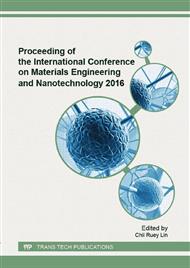[1]
Bazargan, M. Bazargan, G. Mckay, Optimization of rice husk pretreatment for energy production, Renewable Energy 7 (2015) 512-520.
DOI: 10.1016/j.renene.2014.11.072
Google Scholar
[2]
Paddy statistics of Malaysia, http: /www. doa. gov. my.
Google Scholar
[3]
J. Alvarez, G. Lopez, M. Amutio, J. Bilbao, M. Olazar, Bio-oil production from rice husk fast pyrolysis in a conical spouted bed reactor, Fuel 128 (2014) 162-169.
DOI: 10.1016/j.fuel.2014.02.074
Google Scholar
[4]
F. Adam, J. Andas, I. Ab. Rahman, The synthesis and characterization of Cobalt-Rice Husk Silica Nanoparticles, The Open Colloid Sci. J. 4 (2011) 12-18.
DOI: 10.2174/1876530001104010012
Google Scholar
[5]
L. Ding, B. Zou, L. Shen, C. Zhao, Z. Wang, Y. Guo, X. Wang, Y. Liu, , A simple route for consecutive production of activated carbon and liquid compound fertilizer from rice husk, Colloids Surf. A. Physiochem. Eng. Apects 446 (2014) 90-96.
DOI: 10.1016/j.colsurfa.2014.01.055
Google Scholar
[6]
P. Jeetah, N. Golaup, K. Buddynauth, Production of cardboard from waste rice husk, J. Environ. Chem. Eng. 3 (2015) 52-59.
DOI: 10.1016/j.jece.2014.11.013
Google Scholar
[7]
G.S. Chaubey, C. Barcena, N. Poudyal, C. Rong, J. Gao, S. Sun, J.P. Liu, Synthesis and stabilization of Fe-Co nanoparticles, J. Am. Chem. Soc. 129 (2007) 7214-7215.
DOI: 10.1021/ja0708969
Google Scholar
[8]
Q. Li, H. Li, V.G. Pol, I. Bruckental, Y. Koltypin, J.C. Moreno, I. Nowike, A. Gedanken, Sonochemical synthesis, structural and magnetic properties of air-stable Fe/Co alloy nanoparticles, New J. Chem. 27 (2003) 1194-1199.
DOI: 10.1039/b302136j
Google Scholar
[9]
K.N. Collier, N.J. Jones, K.J. Miller, Y.L. Qin, D.E. Laughlin, M.E. McHenry, Controlled oxidation of Fe-Co Magnetic nanoparticles to produce faceted FeCo/ferrite nanocomposites for rf heating applications, J. Appl. Phys. 105 (2009) 1-3.
DOI: 10.1063/1.3054376
Google Scholar
[10]
S.J. Lee, J.H. Cho, C. Lee, J. Cho, Y.R. Kim, J.K. Park, Synthesis of highly magnetic graphite-encapsulated Fe-Co nanoparticles using a hydrothermal process, Nanotechnology, 22 (2011) 1-7.
DOI: 10.1088/0957-4484/22/37/375603
Google Scholar
[11]
G. Suresh, P. Saravanan, D.R. Babu, One-pot synthesis of Fe-Co nanospheres by modified polyol process and their structural, magnetic studies, J. Phys. Conf. Ser. 292 (2011) 1-5.
DOI: 10.1088/1742-6596/292/1/012015
Google Scholar
[12]
V.M. Chakka, B. Altuncevahir, Z.Q. Jin, Y. Li, J.P. Liu, (2006). Magnetic nanoparticles produced by surfactant-assisted ball milling, J. Appl. Phys, 99 (2006) 1- 3.
DOI: 10.1063/1.2170593
Google Scholar
[13]
P. Karipoth, A. Thirumurugan, R.J. Joseyphus, Synthesis and magnetic properties of flower-like FeCo particles through a one-pot polyol process, J. Colloid Interface Sci. 404 (2013) 49-55.
DOI: 10.1016/j.jcis.2013.04.041
Google Scholar
[14]
F. Adam, J. Andas, I. Ab. Rahman, A study on the oxidation of phenol by heterogeneous iron silica catalyst, Chem. Eng. J. 165 (2010) 658-667.
DOI: 10.1016/j.cej.2010.09.054
Google Scholar
[15]
C. Wu, Y. Kong, F. Gao, Y. Wu, Y. Lu, J. Wang, L. Dong, Synthesis, characterization and catalytic performance for phenol hydroxylation of Fe-MCM-41 with high iron content, Micropor. Mesopor. Mater. 113 (2008) 163-170.
DOI: 10.1016/j.micromeso.2007.11.013
Google Scholar
[16]
J. Andas, F. Adam, I. Ab. Rahman, Sol-gel derived mesoporous cobalt silica catalyst: Synthesis, characterization and its activity in the oxidation of phenol, Appl. Surf. Sci. 315 (2014) 154-162.
DOI: 10.1016/j.apsusc.2014.07.118
Google Scholar
[17]
H. Mohammad-Beigi, S. Yaghmaei, R. Roostaazad, H. Bardania, A. Arpanaei, Effect of pH, citrate treatment and silane coupling agent concentration on the magnetic, structural and surface properties of functionalized silica-coated iron oxide nanocomposites particles, Physica E 44 (2011).
DOI: 10.1016/j.physe.2011.10.015
Google Scholar
[18]
D. Garta, G. Mountjoy, M. Gass, G. Navarra, M.F. Casula, A. Corrias, Structural characterization study of FeCo alloy nanoparticles in a highly aerogel silica matrix, The J. Chem. Phys. 127 (2007) 204705-204710.
DOI: 10.1063/1.2799995
Google Scholar


